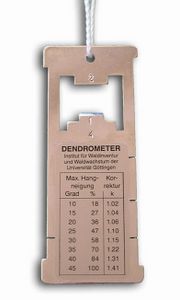Dendrometer
(→Estimation of basal area per hectare) |
|||
| Line 14: | Line 14: | ||
When a width of 2 or 4 is used (width op resp. ''mn''), the resulting basal area (number of trees counted) must be multiplied by the corresponding factor (2 or 4) in order to obtain estimates of basal area per hectare. | When a width of 2 or 4 is used (width op resp. ''mn''), the resulting basal area (number of trees counted) must be multiplied by the corresponding factor (2 or 4) in order to obtain estimates of basal area per hectare. | ||
| − | With relascope sampling on slopes it is necessary to multiply the resulting basal area per hectare with the coefficient k (k=1/cos α) for the respective maximal inclination of slope from the table on the Dendrometer. | + | With relascope sampling on slopes it is necessary to multiply the resulting basal area per hectare with the coefficient k (k=1/cos α) for the respective maximal inclination of slope from the table on the Dendrometer. |
| + | [[File:dendrometer3.jpg|center]] | ||
Revision as of 15:18, 1 November 2010
Kramer's Dendrometer
The Dendrometer (according to Kramer) is a simple measurement device that is suitable for the estimation of basal area per hectare, stand volume and rough estimates of tree height and volume partitioning of single trees. The Dendrometer II is manufactured and distributed by the Department of Forest Inventory and Remote Sensing at the university of Göttingen.
Height measurement
Hold the dendrometer vertically before the eye (opening on top) and aim at the tree to be measured. Adjust the distance of the Dendrometer from the eye or your distance from the tree until the points k and h correspond to the tree tip resp. to the bottom of the trunk. The relation of the section hi to line hk is 1:10. the height of point i corresponds to 1/10 of the tree height. In order to calculate the tree’s height measure the distance from i on the tree to the tree base and multiply by 10.
Estimation of basal area per hectare
The estimation of basal area is based on the principle of relascope sampling invented by Walter Bitterlich. Aim at the dbh of each tree in a 360° sweep (from your standpoint). The basal area is a function of the angle and the number of stems which appear wider than the respective angle opening. Trees with width smaller than fg are not included in the sample (counted). If you hold the dendrometer vertically at a distance of 50 cm before the eye r (distance to the eye is fixed with rs is 50 cm), then the opening with the width fg creates an angle for which every counted tree corresponds to 1 m² basal area per hectare (factor = 1).
When a width of 2 or 4 is used (width op resp. mn), the resulting basal area (number of trees counted) must be multiplied by the corresponding factor (2 or 4) in order to obtain estimates of basal area per hectare. With relascope sampling on slopes it is necessary to multiply the resulting basal area per hectare with the coefficient k (k=1/cos α) for the respective maximal inclination of slope from the table on the Dendrometer.
